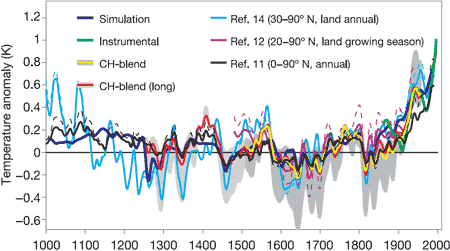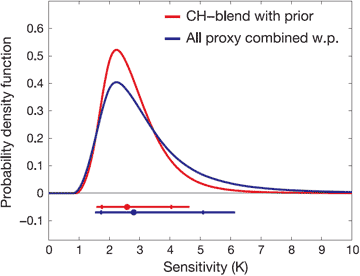What does past climate change tell us?
Posted on 21 October 2009 by John Cook
If there's one thing that all sides of the climate debate can agree on, it's that climate has changed naturally in the past. Long before industrial times, the planet underwent many warming and cooling periods. This has led some to conclude that if global temperatures changed naturally in the past, long before SUVs and plasma TVs, nature must be the cause of current global warming. Ironically, this conclusion is the opposite to what peer reviewed science has found.
Our climate is governed by a simple principle. When the planet has an energy imbalance, global temperature changes. Say the planet is in positive energy imbalance. More energy is coming in than going out. The planet accumulates heat and global temperature gradually rises (not monotonically, of course, internal variability will add noise to the signal). Eventually, the planet returns to equilibrium at a higher temperature. The key question is how much does temperature change for a given change in heat content. This is determined by the planet's climate sensitivity. The change in global temperature can be expressed by the following equation:

DT is the change in global temperature. RF is the radiative forcing, the change in net energy flow at the top of the atmosphere. This might be due to the sun getting brighter. Or a volcanic eruption spewing sulfate aerosols into the atmosphere, reflecting sunlight and letting less energy in. When radiative forcing RF is positive, it means the planet is accumulating heat. Lastly, l is the climate sensitivity parameter. This is a measure of how sensitive our climate is to changes in our climate's heat content.
The most common way of describing climate sensitivity is how much global temperature would change if CO2 is doubled. What does this mean? This is not to say CO2 is the only driver of climate. The amount of energy absorbed by the extra CO2 is calculated using line-by-line radiative transfer codes. These results have been experimentally confirmed by satellite and surface measurements. The radiative forcing from a doubling of CO2 is 3.7 Wm-2 (IPCC AR4 Section 2.3.1). So when we talk about the climate sensitivity to doubled CO2, specifically, we're talking about how much global temperatures would change when the climate experiences a radiative forcing of 3.7 Wm-2.
What is the result from a radiative forcing of 3.7 Wm-2? If we lived in a climate with no feedbacks, global temperatures would rise 1.2°C (Lorius 1990). However, our climate has feedbacks, both positive and negative. The most dominant positive feedback is water vapour - as temperature rises, so too does the amount of water vapour in the atmosphere. However, water vapour is a greenhouse gas which causes more warming which leads to more water vapour and so on. There are also negative feedbacks - more water vapour in the air can cause more clouds which reflects incoming sunlight, resulting in a cooling effect.
So what is the net feedback? We can calculate climate sensitivity from empirical measurements. One needs to find a period where we have temperature records and determinations of the various climate forcings that drove the climate change. If we can measure the change in temperature DT and the radiative forcing RF, climate sensitivity l can be calculated.
Hansen 1993 is one of the earlier determinations of climate sensitivity, examining the period when the Earth fell into the last major ice age. They calculated the change in Earth's albedo due to growing ice sheets. Ice core measurements yielded falling levels of greenhouse gases and increased atmospheric aerosols. From the surface and atmospheric changes, they were able to calculate a net radiative forcing. Coupling this with the temperature record, they found climate sensitivity to be 3 ± 1°C for a doubling of CO2. This means our climate has net positive feedback.
Over the last 1000 years, we've experienced climate change such as the Medieval Warm Period around AD 800-1300. This was followed by the Little Ice Age, roughly spanning the 16th century to the mid 19th century. Hegerl 2006 looks at Northern Hemisphere temperatures spanning both periods, using 4 different temperature reconstructions.

Figure 1: 4 different palaeoclimatic records over the past 1000 years (Hegerl 2006).
They calculate forcing from solar variations, volcanic activity and greenhouse gas forcing. They find a climate sensitivity range of 1.5 to 6.2°C, with the most likely value around 2.6°C. Again, confirmation of net positive feedback.

Figure 2: Probability density functions (PDFs) for equilibrium climate sensitivity to CO2 doubling (in K). Combined estimate using a result from instrumental data as prior distribution.
Hegerl found the temperature record with the most variety yielded the greatest climate sensitivity. And thus we come to the great irony in the argument that past climate change proves humans can't change global temperatures now.
CO2 has caused an accumulation of heat in our climate. We know the radiative forcing from CO2, confirmed by empirical observations. The effect of this heat build-up on global temperatures is determined by climate sensitivity. The greater climate has changed in the past, the greater the climate sensitivity.
Ironically, when skeptics cite past climate change, they're in fact invoking evidence for climate sensitivity and net positive feedback. Higher climate sensitivity means a larger climate response to CO2 forcing. Past climate change is actually evidence that humans can affect climate now.































 Arguments
Arguments






























- "since climate is demonstrably susceptible to change, it is easy for humans to affect change" - well, I don't know if it's easy, we have to work pretty hard to send 29 gigatonnes of CO2 into the atmosphere every year. But the basic point is true - past climate change shows how sensitive climate is to radiative forcing - therefore it will be sensitive to the radiative forcing from CO2
- "by correlating the recent temperature rise with a doubling of CO2, it is possible to deduce the leverage and scale of this influence" - no, not the case. We deduce the scale of CO2 influence by calculating the radiative forcing from CO2. This is worked out using line-by-line radiative transfer codes. This result is then verified by direct observations of satellites and surface measurements which quantify the amount of longwave radiation that CO2 has sent back to the Earth's surface.
"Has anyone bothered to correlate CO2 with population growth?" Yes, in fact, to quote Monbiot: "A paper published yesterday in the journal Environment and Urbanization shows that the places where population has been growing fastest are those in which carbon dioxide has been growing most slowly, and vice versa. Between 1980 and 2005, for example, Sub-Saharan Africa produced 18.5% of the world’s population growth and just 2.4% of the growth in CO2. North America turned out 4% of the extra people, but 14% of the extra emissions."CO2 is not the only driver of climate. When you add them all together, then you have the net radiative forcing that is driving climate. I've gone back and tweaked the wording of that paragraph, hopefully clarifying the language somewhat. In fact, I'm currently working on a post coincidentally titled "CO2 is not the only driver of climate" :-)
The main controversy with the Medieval Warming Period is whether it was global or a regional phenomenon. However, bickering over how widespread the MWP was underlies the irony of arguing about past climate change. If, as skeptics say, the MWP was a global phenomenon and temperature change was greater than currently thought, that would mean climate is more sensitive than previously thought. Hence the climate reaction to current CO2 radiative forcing would be even larger.
Re Hergerl 2006, you're right, it did use NH reconstructions, not global. Thanks for spotting that, I've updated the post.
I've been asked to "falsify" anthropogenic global warming. I propose using computer models. Are such models available?
Eddie @ 33:
Given that there is no single, simple hypothesis on which "anthropogenic global warming" is based, providing a simple example that would "falsify" it is a dishonest challenge.
The prediction of rising temperature in response to increased greenhouse gases is a logical consequence of many falsifiable aspects of physics. Just a handful, off the top of my head:
By "computer models", I assume that you mean models such as general circulation models used to simulate global climate. Such models are really just "computer solutions to mathematical models". The mathematical equations in such models are many - and cover the many aspects of physics that are required. All of those equations are - in principle - falsifiable. All of them have strong evidence that they are reasonably correct - i.e., nothing has been observed that would falsify the theories that they describe.
Eddie @33
Here is an old blog post from 2014 which gives some examples of how it would be falsifiable:
Is Climate Science falsifiable?
BAERBELw@35, Bob Loblaw@34
Thanks!
"As a matter of fact, the ‘AGW-hypothesis’ is not a hypothesis in the Popperian sense. The human impact on climate is a theory, supported by many hypotheses, each of them tested according to widely accepted scientific standards. Just as Popper and his successors in the philosophy of science would have wanted."
EddieEvans,
If the responses by Bob Loblaw and BaerbelW fail to help you satisfy the people challenging you to 'falsify the understanding that human activity, particularly the burning of fossil fuels, is causing global warming' there may be another way to obtain satisfaction.
You could advise those who demand an evidence-based test that would 'attempt to falsify the understanding that human activity is causing global warming' that such a test would be as follows:
An alternative 'falsification test' would be to find another earth-like planet with a humanoid population that has developed without the 'understood global warming impacts' but still experienced rapid global warming like the type that is currently occurring on this planet.
Note that the harmful consequences of failing to reduce impacts ‘because of wishes to have falsification tests done’ make the alternative of ‘finding an alternate planet’ highly unlikely to be ‘completed in time to be helpful’.